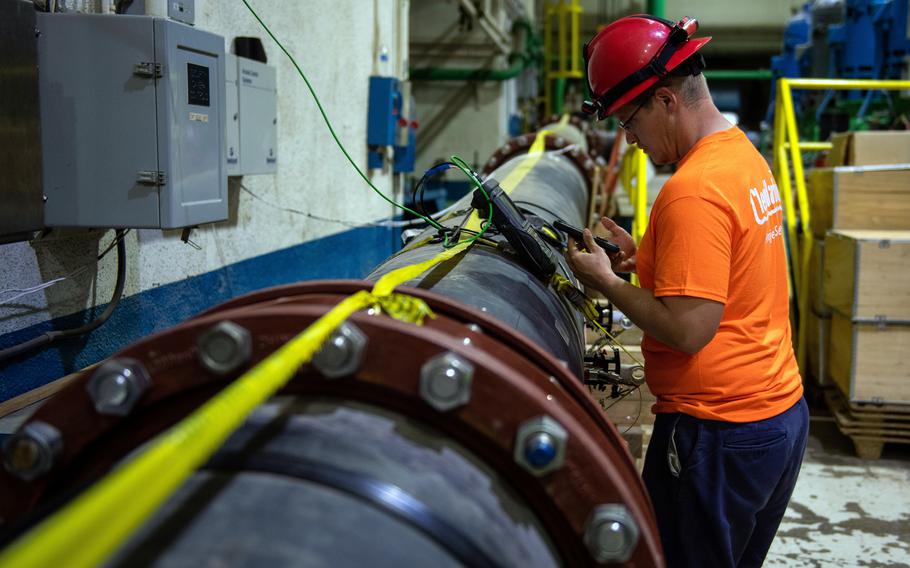
A Navy contractor inspects a water pipe that connects to a granular activated carbon system at the Red Hill well near Joint Base Pearl Harbor-Hickam, Hawaii, in April 2022. (Mar’Queon A. D. Tramble/U.S. Navy)
HONOLULU — Medical problems reported by residents of military housing in Hawaii in late 2021 were not caused by tap water contaminated by Navy jet fuel, a toxicologist said Wednesday in Hawaii federal court.
“I concluded that they were not toxicological,” Robyn Prueitt testified on behalf of the U.S. government, the defendant in a civil suit brought by military families alleging physical and mental illnesses from consuming the water.
Prueitt, who works for the environmental consulting firm Gradient, testified her conclusion was based upon the existing medical literature about the effects of JP-5 jet fuel exposure on human health and on the estimated amount of jet fuel in the plaintiffs’ tap water.
“There are no reliable human studies of JP-5,” she said.
The 17 plaintiffs, who lived in military communities near Joint Base Pearl Harbor-Hickam in late 2021, say exposure to the tainted water sparked a host of medical problems, including headaches, nausea, dizziness, brain fog, anxiety and tremors.
Plaintiffs testified last week that some medical issues remain after two years and in some cases have grown worse.
U.S. District Court Judge Leslie Kobayashi, who is hearing the case without a jury, has said numerous times from the bench that the purpose of the trial is to determine the cause of the alleged injuries and what compensation, if any, the plaintiffs should receive.
Plaintiffs attorney Kristina Baehr cross-examined Prueitt based on the toxicologist’s previously submitted, sworn declaration in the case.
Prueitt testified that stress from “the incident itself and the perception of the individuals” could have manifested in the conditions felt by the plaintiffs.
“Certain health symptoms can occur in individuals in response to an odorous chemical that is perceived to be unpleasant or unhealthy at exposure concentrations lower than the toxicity threshold, but these symptoms are a result of stress-induced responses to perceptions of the odor as a health risk (i.e., a non-toxicological mechanism),” Prueitt stated in her declaration.
Baehr cited several studies examining the effects of JP-5 fuel on health that Prueitt did not include in her review, including a 2023 study in the Journal of Water and Health titled “Community health impacts after a jet fuel leak contaminated a drinking water system: Oahu, Hawaii, November 2021.”
“I did not consider reports that have self-reported symptoms,” Prueitt said.
“These types of studies are published all the time,” she said. “It doesn’t mean they are reliable.”
Earlier in the day, Walter Grayman, an environmental and civil engineer, testified for the defense about modeling he had formulated to determine levels of JP-5 jet fuel in the Navy’s water system between Nov. 24 and Dec. 5, 2021.
His model found that the contamination was limited to certain areas of the water system and that it was diluted relatively quickly during the 12-day period he analyzed.
His findings contrasted with modeling done by the plaintiffs’ water expert, Paul Rosenfeld, who testified earlier in the trial that JP-5 fuel entered the Navy’s water system in enough density to produce sheens on water in many homes.
Rosenfeld testified Tuesday that his “well-mixed” model considered that hydrocarbon liquids such as diesel and jet fuel will dissolve when mixed with water if the petroleum liquid is less than 5 milligrams per liter.
Concentrations greater than that will leave a sheen atop water, which residents across the Navy’s water system reported through early December 2021, he said.
“The entire system is highly interconnected,” Rosenfeld testified Tuesday.
Prueitt testified that she based her conclusions using Grayman’s model.
Questioned further by Baehr, Prueitt acknowledged that if Grayman’s model did not offer accurate JP-5 concentrations then her conclusions would “be off by that much.”